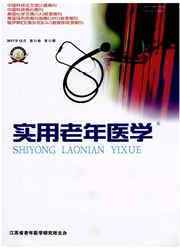

 中文摘要:
中文摘要:
目的通过观察老年男性迟发性性腺功能减退症(late onset of hypogonadism,LOH)患者的血清性激素变化情况,探讨性激素对LOH的诊断意义。方法 2009年11月至2014年6月,采用分层多阶段整群抽样方法,选择上海市及浙江省嘉善县17个社区3000例40~80岁中老年男性作为调查对象,分别记录国际勃起功能(IIEF-5)问卷及老年男性症状(AMS)量表,同时测定其血清总睾酮(TT)、黄体生成素(LH)、性激素结合球蛋白(SHBG),计算睾酮游离指数(TSI)、游离睾酮(FT)及生物活性睾酮(Bio-T)。结果研究对象平均年龄为(58.47±8.15)岁,AMS量表筛查LOH的阳性率为34.92%(937/2683)。LOH阳性组人群的TT和LH水平与阴性组比较差异无统计学意义(P〉0.05);FT、TSI在LOH阳性组较阴性组明显降低(P〈0.05);SHBG及Bio-T在2组间差异亦有统计学意义(P〈0.01)。Pearson相关分析显示:TSI、SHBG及Bio-T与LOH显著相关,FT与LOH弱相关,而TT及LH与LOH无明显相关性。结论 SHBG及Bio-T对LOH患者的诊断价值优于TT,Bio-T的下降及SHBG的增高应作为LOH患者重要的诊断指标。
 英文摘要:
英文摘要:
Objective To observe the changes of serum sex hormone in the patients with late onset of hypogonadism( LOH),and to assess its value for diagnosis of LOH. Methods A cross-sectional randomized study of 3000 males aged 40 to 80 years were investigated under structured questionnaires including IIEF-5 and AMS from November 2009 to June 2014 in Shanghai and Zhejiang community. The levels of total testosterone( TT),luteinizing hormone( LH) and sex hormone-binding globulin( SHBG) were detected,and testosterone secreting index( TSI),free testosterone( FT) and bioavailable testosterone( Bio-T) were calculated. The International Index of Erectile Function-5( IIEF-5) and Aging Male Symptoms( AMS) were evaluated. Results The mean age of the males was( 58. 47±8. 15) years old. The positive rate of LOH screened by AMS was 34. 92%. FT and TSI values were lower in LOH patients than those in normal men( P〈0. 05),however,no statistical difference was observed in TT and LH between two groups. The levels of Bio-T and SHBG were closely correlated with LOH( P〈0. 01). Pearson correlation analysis indicated that TSI,SHBG and Bio-T were significantly related to LOH( P〈0. 05). Conclusions Both SHBG and Bio-T play a critical role in reflecting the testerone level of LOH patients. The levels of Bio-T decling and SHBG are important bio-markers to diagnose LOH.
 同期刊论文项目
同期刊论文项目
 同项目期刊论文
同项目期刊论文
 期刊信息
期刊信息
